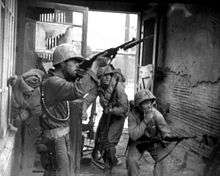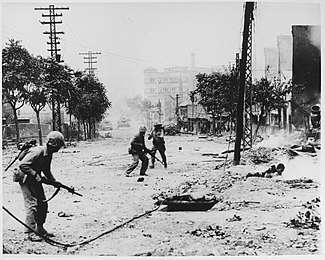Second Battle of Seoul
The Second Battle of Seoul was a battle that resulted in United Nations forces recapturing Seoul from the North Koreans in late September 1950.
Approaching Seoul
Before the battle, North Korea had just one understrength division in the city, with the majority of its forces south of the capital.[5] MacArthur personally oversaw the 1st Marine Regiment as it fought through North Korean positions on the road to Seoul. Control of Operation Chromite was then given to Major General Edward Almond, the X Corps commander. General Almond was in an enormous hurry to capture Seoul by September 25, exactly three months after the North Korean assault across the 38th parallel.[6]

The advance on Seoul was slow and bloody after the landings at Inchon. The reason was the appearance in the Seoul area of two first-class fighting units of the Korean People's Army (KPA), the 78th Independent Infantry Regiment and 25th Infantry Brigade, about 7,000 troops in all.[7]
The KPA launched a T-34 attack, which was trapped and destroyed, and a Yak bombing run in Incheon harbor, which did little damage. The KPA attempted to stall the UN offensive to allow time to reinforce Seoul and withdraw troops from the south. Though warned that the process of taking Seoul would allow remaining KPA forces in the south to escape, MacArthur felt that he was bound to honor promises given to the South Korean government to retake the capital as soon as possible.
On the second day, vessels carrying the U.S. Army's 7th Infantry Division arrived in Incheon Harbor. General Almond was eager to get the division into position to block a possible enemy movement from the south of Seoul. On the morning of September 18, the division's 2nd Battalion, 32nd Infantry Regiment landed at Incheon and the remainder of the regiment went ashore later in the day.

The next morning, the 2nd Battalion moved up to relieve a U.S. Marine battalion occupying positions on the right flank south of Seoul. Meanwhile, the 7th Division's 31st Infantry Regiment came ashore at Incheon. Responsibility for the zone south of Seoul highway passed to the 7th Division at 18:00 on September 19. The 7th Infantry Division then engaged in heavy fighting with KPA forces on the outskirts of Seoul.
The Battle
The Marines entered Seoul shortly after 7:00am on September 25 to find it heavily fortified. Buildings were heavily defended by machine guns and snipers, and on Ma Po Boulevard, the main road through the city, the KPA had established a series of 8-foot-high barricades of burlap bags, typically filled with either sand or rice. Located about 200-300 yards apart, each major intersection of the city featured such a barricade, the approaches to which were laced with mines, and which were usually defended by a 45mm anti-tank gun and machine guns. Each had to be eliminated one at a time, and it took the Marines, on average, 45–60 minutes to clear each position.[8] Casualties mounted as the Americans engaged in heated house-to-house fighting. Edwin H. Simmons, a Major in 3rd Battalion, 5th Marines, likened the experience of his company's advance up the boulevard to "attacking up Pennsylvania Avenue towards the Capital in Washington, D.C." He described the street as "once a busy, pleasant avenue lined with sycamores, groceries, wine, and tea shops."[9] Anxious to pronounce the conquest of Seoul on MacArthur's insistence by the third-month anniversary of the war, Almond declared the city liberated on September 25, although Marines were still engaged in house-to-house combat (gunfire and artillery could still be heard in the northern suburbs). Effective resistance would cease by September 28.
After the battle, South Korean police executed citizens and their families who were suspected as communist sympathizers in what is known as the Goyang Geumjeong Cave and Namyangju massacres.[10][11]
See also
- Eugene A. Obregon, US Marine posthumously awarded the Medal of Honor for shielding a fellow Marine during the battle
- First Battle of Seoul
- Third Battle of Seoul
- Operation Ripper
Notes
- Halberstam The Coldest Winter, p. 302.
- Hoyt, Edwin P. (1984). On To The Yalu. New York: Stein and Day. p. 98.
- http://www.history.army.mil/books/korea/20-2-1/sn26.htm . Look at "THE CAPTURE OF SEOUL" Page 541 for casualty figures. Subtract Battle of Inchon casualties from the total Inchon-Seoul casualties from this source
- http://www.history.army.mil/books/korea/20-2-1/sn26.htm . Page 540
- Baldwin, Hanson W. (September 27, 1950), "Invasion Gamble Pays", The New York Times, p. 6, retrieved June 18, 2006
- Hoyt, Edwin P. (1984). On To The Yalu. New York: Stein and Day. p. 77.
- Hoyt, Edwin P. (1984). On To The Yalu. New York: Stein and Day. p. 98.
- http://www.koreanwar2.org/kwp2/usmckorea/PDF_Monographs/KoreanWar.Battle-Barricades.pdf
- http://www.koreanwar2.org/kwp2/usmckorea/PDF_Monographs/KoreanWar.Battle-Barricades.pdf
- "Goyang Geumjeong Cave Massacre memorial service". Hankyoreh. February 9, 2010. Retrieved November 29, 2011.
- Charles J. Hanley and Jae-Soon Chang (December 6, 2008). "Children 'executed' in 1950 South Korean killings". Associated Press; San Diego Union-Tribune. Retrieved September 2, 2012.
References
- Halberstam, David (2007). The Coldest WInter – America and the Korean War. New York: Hyperion. ISBN 978-1-4013-0052-4.
- Hoyt, Edwin P., On To The Yalu, (1984), ISBN 0-8128-2977-8

